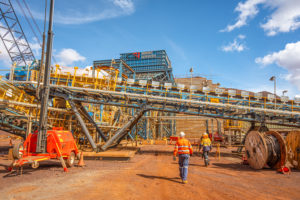Australia’s Mineral Resources Ltd (MRL) says it is always looking at ways to work safer, create efficiencies and reduce its environmental impact. At the heart of this approach is innovation, which has seen the company reveal a number of mining firsts. One of these is the NextGen 2 crusher – a ground-breaking, relocatable modular crushing and screening plant which is operating successfully for a MRL client in the Pilbara region of Western Australia.
“The benefits extend beyond speed of installation, lower operating costs and the need for limited site works. Since IM last reported on the NextGen2 crusher some early performance results have come through. The NextGen 2 is demonstrating its capability to process ore with both a low moisture content and with a higher moisture content, such as marra mamba ore. Originally designed for ore with moisture levels of around 4-6%, the NextGen 2 is processing ore with moisture up to 15-16%, and averaging between 10-12%. Ore with a higher moisture content would usually require a below water table style plant (wet plant), which has a higher cost than an above water table style plant (dry plant). Having the capability to process both a lower moisture ore and a higher moisture ore with the one plant is an exciting prospect and has the potential to open up opportunities to lower the processing cost of higher moisture ore bodies.”
MRL also says independent testing has also verified that the NextGen technology is better for people and the environment, with the plant emitting less dust and noise than traditional crushers. As the world’s largest crushing and screening contractor, MRL says it sees NextGen forming a big part of future crushing strategies for iron ore mines, as well as other commodities such as gold, copper and lithium.

However, MRL’s innovations also extend to carbon fibre technology. In what it says is a world first, MRL has successfully developed carbon fibre vibrating screens for its crushing and wet processing plants, which look set to take the place of traditional steel vibrating screens and bring a host of life-of-plant cost and productivity benefits.
Constantly on the move as they classify ore into different size fractions, vibrating screens made of steel are prone to fatigue corrosive cracking. In contrast, carbon fibre screens are lightweight, corrosion resistant and have a significantly higher structural strength than carbon steel. With a service life its says 3-5 times longer than steel screens the carbon fibre screens offer significant cost benefits, with MRL able to manufacture them in-house at its own facility in Bibra Lake, Western Australia. MRL has commenced in-field testing, replacing a traditional steel screen with a carbon fibre screen in an existing processing plant at one of its lithium mine sites.
Finally, MRL says ceramic liners are another crusher component which look set to be revolutionised with carbon fibre technology. MRL is exploring the in-house manufacture of composite ceramic liners in a polyurethane matrix, which will be used to protect material handling equipment such as large vibrating screens from abrasion and impact wear. Ceramic is extremely durable and offers anticorrosion properties. According to MRL, a transition from traditional steel liners provided by external suppliers to composite ceramic liners manufactured in-house has the potential for a host of safety, cost and environmental benefits. Ceramic liners last longer so they don’t have to be replaced as often, meaning less human interaction required to replace liner systems inside material handling assets, lower volume of spent liners and reduced environmental impact.











